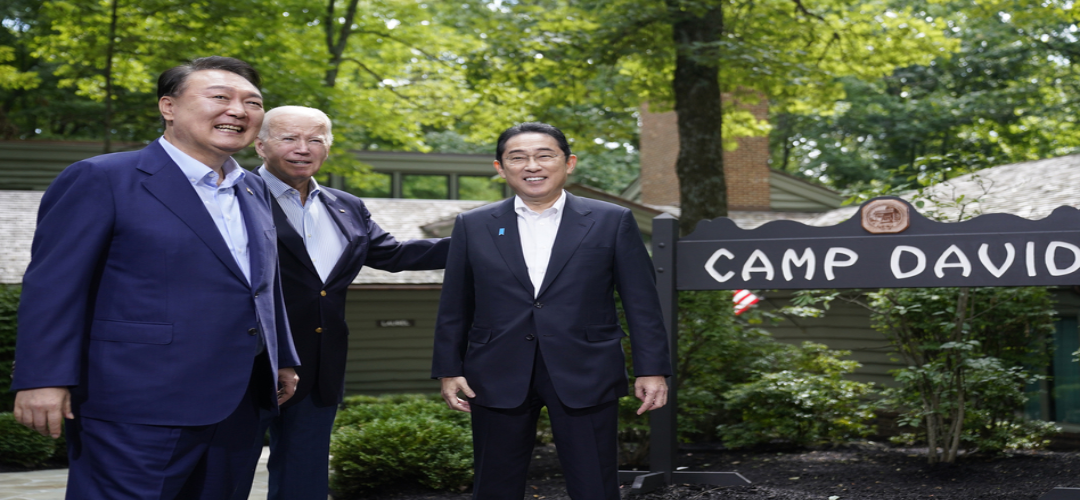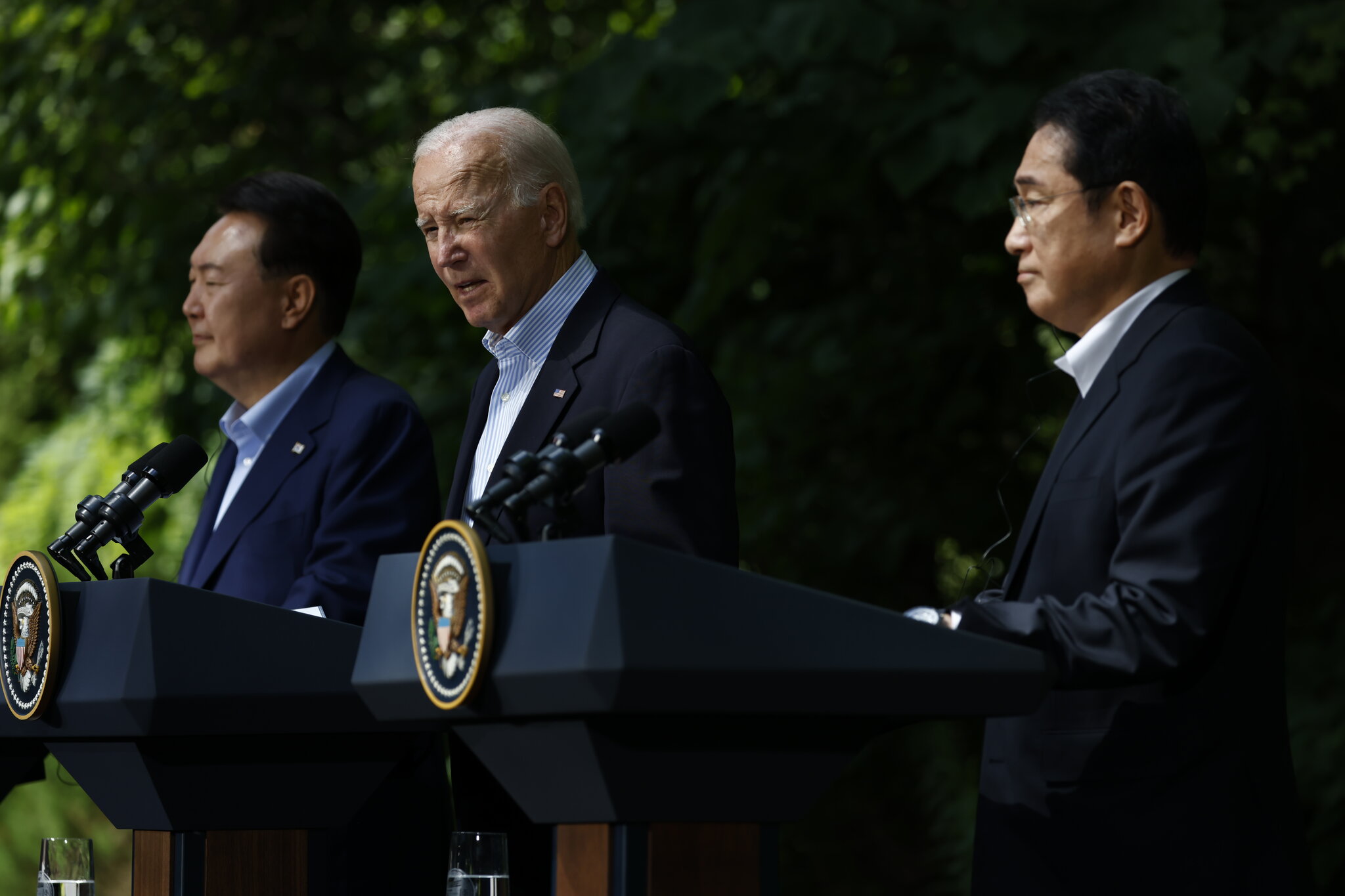Facing the Dragon, Jointly
August 26, 2023 | Expert Insights

China's massive shadow over its immediate region has seldom been benign, even far back in history, notwithstanding that this giant invaded far fewer countries than its smaller neighbours. Now, the clock has fully turned, and China stands at the threshold of world domination, a fact that inspires little confidence in its neighbourhood.
No two-neighbouring country of China looks at the Middle Kingdom in the same way. This has prevented any joint collaboration amongst these countries against Beijing until now. The perceived threat varies from country to country, with some, like Japan, having a legacy of their imperial occupation of China and a brutal legacy at that. Japan also has some lingering territorial disputes, just like the various littoral countries of the disputed South China Sea.
On August 18th, President Joe Biden, Japanese Prime Minister Fumio Kishida and South Korean President Yoon Suk-yiol summitted at Camp David, an event that drew international attention. Incidentally, this Summit was the fourth meeting between President Biden, Prime Minister Kishida, and President Yoon over the preceding fourteen months. As per the White House Fact Sheet, the Summit was aimed at “ strengthening trilateral security cooperation, including through enhanced trilateral defence exercises, improved information sharing, and increased cooperation on ballistic missile defence, including against the DPRK’s missile threat.”
CGTN (China Global Television Network) called it a provocative move in the Pacific Region as the three states aligned to “counter China.” It warned that the new alliance, if formalised, would shape the shifting world order and could ignite a tense faceoff. Coming at the heels of the QUAD and AUKUS, it is not surprising that the Chinese feel they are increasingly being encircled, economically and militarily. This is a dangerous state of mind, as being pushed to a corner can never lead to a peaceful outcome. After all, saving face is an overpowering oriental characteristic!
Background
This is not the first time that a multilateral security framework has been proposed in China's neighbourhood. This has antecedents in the past. At the beginning of the Cold War, Communist China was in the Soviet camp while serving its own military interests in Indo-China and Korea, bringing it into a military confrontation with the West. However, then, the battle was more ideological in nature between unequals.
China had to confront regional security frameworks like the Southeast Asia Treaty Organization (SEATO). While SEATO did not last very long as the foundational purpose lacked conviction, it fuelled Chinese suspicions of Western intentions, a sentiment that persists.
Failing to create an Asian version of NATO, Washington opted to work out bilateral security agreements in the Asia Pacific. These were less complicated and more subtle in nature, and this made potential allies like Japan and South Korea more comfortable with them. While smug under the security umbrella provided by the U.S., it allowed them to go ahead with their commercial interests in China on their respective roads to prosperity without being dragged into a broader security framework. But Beijing’s increasing belligerence has made this arrangement untenable, and Ukraine could have acted as a catalyst.

Analysis
Ever since Russia invaded Ukraine, the world order has been over-turned. A China-Russia axis has tentatively appeared on the horizon. Despite Ukraine not being part of NATO, the bloc has stepped in robustly and turned the Russian 'special military operation' into a prolonged war of attrition with no clear winners as yet. China and its neighbours have been watching all this closely as the war has a message for everyone.
Smaller and weaker neighbours of China would gain confidence from the Russian predicament wherein a weaker adversary, albeit a tenacious one, has turned the tide against one of the most powerful militaries on the globe over a terrain that greatly favours the offensive. In contrast, China has to cross a formidable anti-tank ditch in the form of the Taiwan Straits, followed by the mountainous cave-riddled fortresses that guard the island of Taipei.
With China's relations with the West strained, things are much more on a hair-trigger. Any small misunderstanding could cause a geopolitical explosion between the two powers. In such a situation, countries like Japan and South Korea are concerned and wish to refocus the attention of the U.S. away from Ukraine and back to their region. The increasing bellicosity of Pyongyang, playing the game of brinkmanship with ballistic missiles, also gives little comfort.
The Chinese abhor the entry of external big powers into the region. They have always insisted that an Asian security structure must be established from within the region rather than inviting outside powers. This system would obviously benefit Beijing. Being the largest country, it would have a natural advantage over its smaller East and Southeast Asian neighbours. Whether such an arrangement would bring genuine peace or give China unbridled dominance is a matter of debate.
The multilateral security framework is thus better at achieving regional stability. Still, there are many hurdles to be crossed. There can be no territorial disputes between partner countries like the one that exists now between Japan and South Korea. Both governments in the recent past have made genuine efforts to reach out, yet the pain, suspicion and centuries-old hatred go too deep to be erased in one stroke.
Building alliances is more than just about friendships. It is also about trusting each other completely. When you share military secrets and carry out joint military action, then any lack of trust could prove to be fatal. Whether such a high level of trust exists between Japan and South Korea remains to be seen.
The United States has always tried to nudge these two countries together. It has attempted to use its good offices to act as an honest broker between the two sides.
Another cause for concern is how willing South Korea and Japan are to actually be part of an anti-China alliance in deeds. The world at present is more integrated than ever before, especially from the economic point of view. In such an interconnected world, military decisions cannot be taken in isolation. Both Japan and South Korea trade extensively with China. In the South Korean case, the connections with the Chinese economy are much closer. China is South Korea’s largest trading partner.
There have been some major achievements at this Summit. Japan has finally decided to come out of its shell and engage strategically with its East Asian neighbours. The Japanese no longer see the U.S. protective umbrella as enough. They understand that only regional unity can make Beijing see reason. For this, Tokyo is willing to compromise with South Korea. Relations might not be as close as those between NATO countries, but things can still work out.
A three-way hotline has been set up between the United States, Japan and South Korea for crisis communications. Deeper cooperation in ballistic missiles has been agreed upon. For South Korea, this challenge is much more existential. It constantly faces the threat of ballistic launches from North Korea without any warning. It has also been decided that there should be more joint military exercises between these three countries. This will increase the mutual compatibility between all three militaries.
India View
What does all this mean for India? New Delhi has moved forward on a robust security relationship with Tokyo. This security cooperation is both at the bilateral level and also at the multilateral level through the Quad mechanism. Defence and security dialogues between the two countries take place at regular intervals. Joint naval exercises have been carried out by the two navies.
In the case of South Korea, the relationship with India has mostly been economic in nature. But defence cooperation between New Delhi and Seoul is slowly rising. The most visible example is the highly effective K9 Vajra, a 155 mm, 52-calibre tracked self-propelled howitzer system built in India by Larsen & Toubro with technology transferred from South Korean defence major Hanwha Defence based on its K9 Thunder. That the gun is a force multiplier in the high Himalayas where the Indian Army is facing the Chinese opposite Ladakh is significant. In light of all this, any strategic alignment between Japan and South Korea will ultimately be beneficial for India.
The main question that has remained unanswered from this Summit is whether this is an openly anti-China initiative. China has already called this gathering a “mini-NATO” in Asia. Denial has come fast and swift from the other side. The U.S. President has himself cleared the air by stating that "This summit was not about China. This was not the purpose”. His National Security Advisor Jake Sullivan has added to this by saying, "Its explicitly not a NATO for the Pacific". All these denials are hard to believe, even for a neutral observer.
Assessment
- The very fact that Japan and South Korea have agreed to join hands is being touted as an achievement. The coming together of South Korea and Japan rests on shaky grounds. Any change in the political administration in either country could result in this arrangement falling apart. Much more needs to be done to institutionalise this arrangement.
- The historical record shows clearly that the NATO structure cannot be replicated in the Asia-Pacific. Mutual distrust is too high here for any common platform with a unified command to be formed.
- This alliance has been formed to contain China, however one puts it. Whether it succeeds in this goal is another matter altogether.








Comments